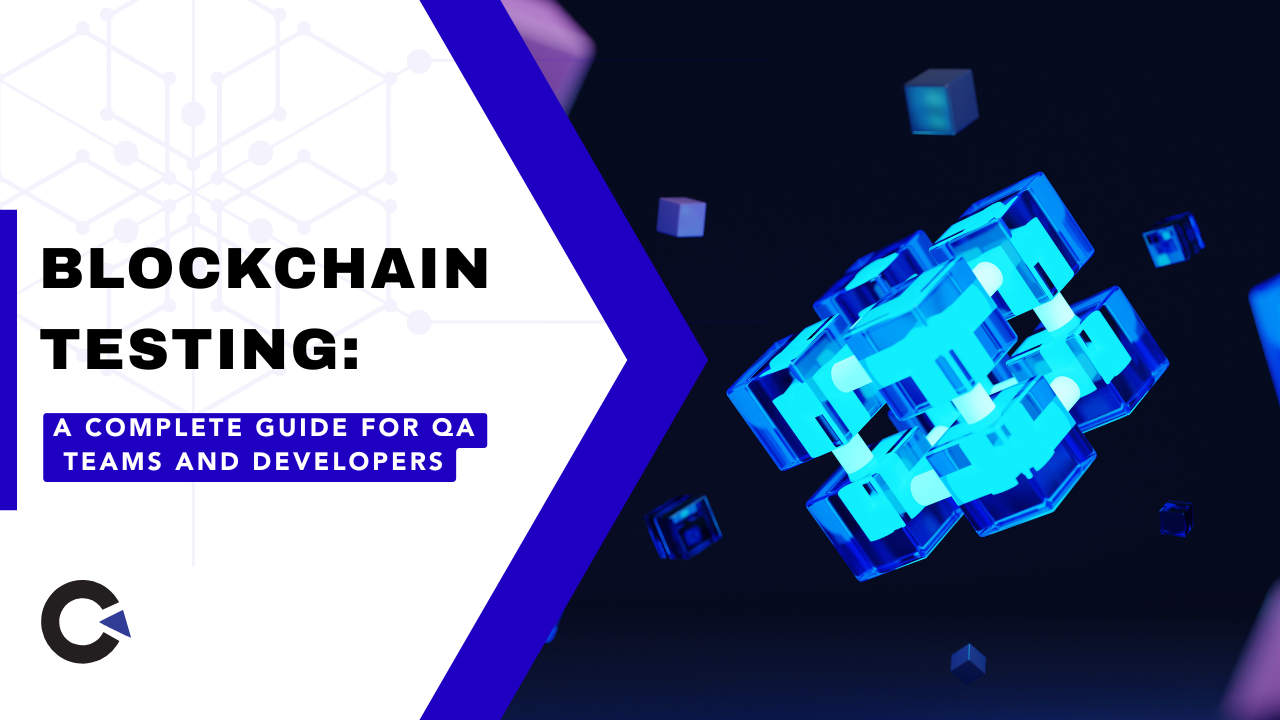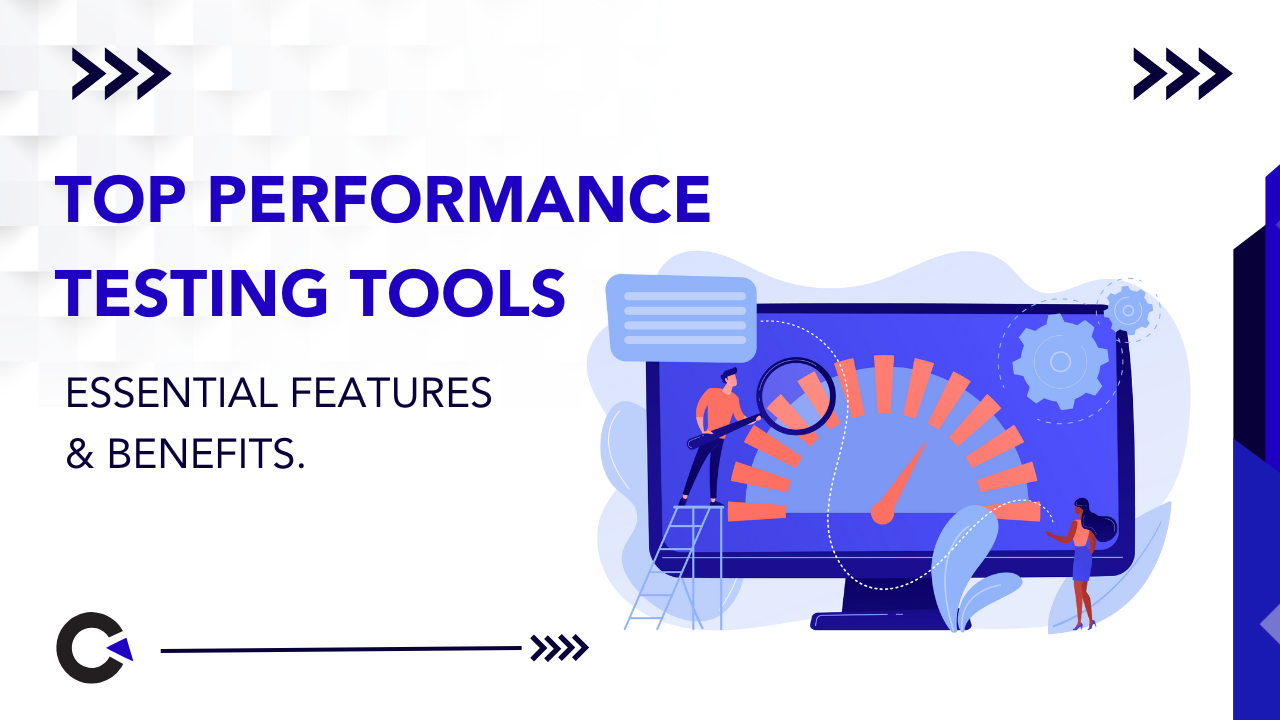
by admin | Dec 8, 2021 | Software Testing, Blog, Latest Post |
Not many know that there is a lot of difference between Quality Assurance and Software Testing. Though they both contribute towards better software quality, they differ in terms of goal, approach, and so on. To put it in simple terms, software testing is the process of finding bugs that already exist in the software. Whereas, Quality Assurance is the process of preventing the creation of such bugs and future problems. So we would first perform software testing to find all the bugs, then with the available data, we will be able to perform quality control to achieve quality assurance. As a leading QA company, we have been able to successfully test products and provide quality assurance to many of our clients. So in this blog, we will be focusing on the core differences between QA and Software testing and explore why Quality Assurance is important.
The Differences between QA and Software Testing
Quality Assurance is much broader in scope as covers every process, policy, tool, guideline, training, workflow, etc. that a team will need to meet with their quality objectives. So software testing is basically a sub-branch of the quality assurance process. Now let’s take a look at the tabulated version of the key differences between QA and Software Testing.
| S. No |
Software Testing |
Quality Assurance |
| 1 |
The Primary Objective Is To Make The Application Bug-Free. |
The Primary Objective Is To Make The Application Meet The Stakeholder’s Expectations. |
| 2 |
Performed Once The Code Has Been Written. |
Involved In Every Step Of The Development Process. |
| 3 |
Checks Or Validates The Behavior Of The Application. |
Improves The Application’s Quality Using Various Methods, Tools, Policies, Etc. |
| 4 |
It Is Reactive In Nature As It Is A Corrective Action. |
It Is Proactive In Nature As It Is A Preventive Action. |
| 5 |
Focused On The Product. |
Focused On The Process. |
| 6 |
Developers Or Testers Perform The Tests. |
Quality Assurance Activities Are Followed By All. (Stakeholders, Business Analysts, Developers, And Testers) |
The Importance of Quality Assurance
We know for a fact that lack of bugs alone doesn’t make a quality product. If we were to go by an analogy, we can consider a dish that has been cooked in accordance with the given recipe & procedure. But what if there was something wrong with the recipe or the cooking process itself? The consumer still may not like the food though everything went according to plan. Likewise, an end-user might not feel satisfied with your product though it is bug-free.
Moreover, believing that the software being developed will have zero errors is a fallacy. Since we are aware of the obvious result, is it not wiser to follow quality assurance methods to minimize the effects of any quality issues later down the pipeline? It is impossible for the software tester who receives the code with the bugs to have any control over the development process. So the more attention and effort you put into quality assurance, the easier it gets while testing a product.
Which one do you need?
So it is evident that creating a successful product without either of these two is not possible. Though companies might have an internal team for executing basic tests, it will not be enough. A dedicated QA team will be mandatory as we all know that quality cannot be tested into a product. If there are any doubts regarding the team’s expansion, one can always outsource their QA needs to one of the best outsourcing companies such as us to get the job done without breaking a sweat while still staying on budget. We hope you are now clear of the various differences between QA and software testing

by admin | Dec 3, 2021 | Software Testing, Blog, Latest Post |
Making a career choice is no easy task, you should know if you’re on the right path by exploring various options, you should then clear any and all misconceptions you might have in the role by taking a deep dive. Following this, you’ll have to check the various skills you’ll need, the certifications to work for and so much more. As a leading software testing company, we know what makes great software testers. So assuming you have checked other options and have made a job in software testing a viable option, we will be exploring all the avenues you’ll need to focus on to become a successful software tester. We will start by introducing you to the role of a software tester so that you will not have any fallacies about the job.
Who are Software Testers?
Software Testers, also known as QA Professionals play an integral part in ensuring the quality of the software in various parts of the software development cycle. The process of ensuring quality involves creating defined expectations that the software is expected to meet and then testing it to see if the said expectations are met. It can either be done manually or by using automation. Software testing doesn’t just require people with an eye for the details as quality goes beyond what meets the eye. Quality should be ingrained in the software tester’s mindset that doesn’t just stop issues but also prevents them from occurring by encouraging the team to follow the best practices.
Quality is such a huge deal as no user would be interested to use buggy software though it has the best features. The software will fail if the team fails to nail to user experience. So software testing isn’t just about detecting bugs, it is about ensuring smooth performance and a great user experience. So let’s take a look at the various skills you will be needing to accomplish this objective.
Skills of a Software Tester
Be it any job, you will need both technical and non-technical skills to excel at it. We will not be compartmentalizing skills based on specific methods of testing as we always believe it is important for a tester to have comprehensive knowledge across all the methods and approaches. If you find this list overwhelming, please keep in mind that these are the skills you will be needing not to just get started. So you can get better at it in the due course time.
Technical Skills Required for Software Tester

Domain Knowledge
Remember how we mentioned there will be defined expectations for the application to meet with? So technically you would have to understand such expectations of the stakeholders and the end-users to create test cases that will define what has to be tested and how it has to be tested. You can’t use one type of test in all scenarios, right? So you would have to learn the different types of testing like performance testing, smoke testing, regression testing, etc., and know when to use what type of testing. Once all this is ready, you must also be in a position to execute these test cases, determine the result of the tests and create test reports. Our Software Testing Tutorial for Beginners is a great blog you can ready to learn such skills. In addition to that, you must familiarize yourself with software development approaches like agile.
Coding
Since software testers would have to understand what the code means when testing an application, it goes without saying that programming is a must-have skill for testers. In addition to that, it is important to improve your coding skills to implement automation to perform repetitive tasks as the need for automation is on the rise to keep up with the demand for quality software. Apart from being able to read and comprehend the code, you must have a high level of understanding of the widely used programming languages. You must also have a stronghold in the basics such as the fundamentals of object-oriented programming, architectures, algorithms, and so on.
Linux Commands
Though Windows and macOS are the most commonly used operating systems for regular use, you should have a basic understanding of Linux commands as the deployment of applications like databases, web services, Docker, Kubernetes, and application servers are deployed on machines running on Linux.
Databases and SQL
Nowadays applications tend to have large chunks of data in their back-end using databases. Since software testing is about ensuring overall quality, it is vital for software testers to have ample knowledge about databases like MYSQL or Oracle. So if you have the task of validating the data in the databases, you should be able to create SQL queries to verify if the data is stored properly or not.
Tool Knowledge
Just like how to test execution requires effort, test management also requires a lot of effort. Using the appropriate tools can reduce the required effort in storing test cases, bug tracking, and so on. So make sure you have awareness and as many hands-on experiences with the tools that can be helpful. As a pioneer in the industry, we have curated lists of the best test management tools and the top 10 automation testing tools every tester must know about. Make sure to visit that blog to find what tools will be best suited for the various requirements.
Certifications
There is a lot a candidate can claim in their resume, and certifications can add a lot of value to your application and help you stand apart from the crowd. Developing all the above-mentioned skills should be the primary objective as there will be no use for you if you decide to get certified just for the sake of getting certified. There are various free certifications that can help you get started and a lot of paid certifications that will help you gain more recognition. So make sure to visit our blog to learn more about the best QA testing certifications that we have mentioned below.
- ISTQB – Foundation Level
- CAST – Certified Associate In Software Testing
- CSTE — Certified Software Test Engineer
- CTM — Certified Test Manager
- CSSBB — Six Sigma Black Belt Certification
- ISTQB – Advanced & Expert Level
It is a comprehensive list of the certifications you should focus on for your career growth and not a starter kit. You could also use platforms like Coursera and Udemy to get a lot of useful certifications.
Non-Technical Skills Needed by a Software Tester
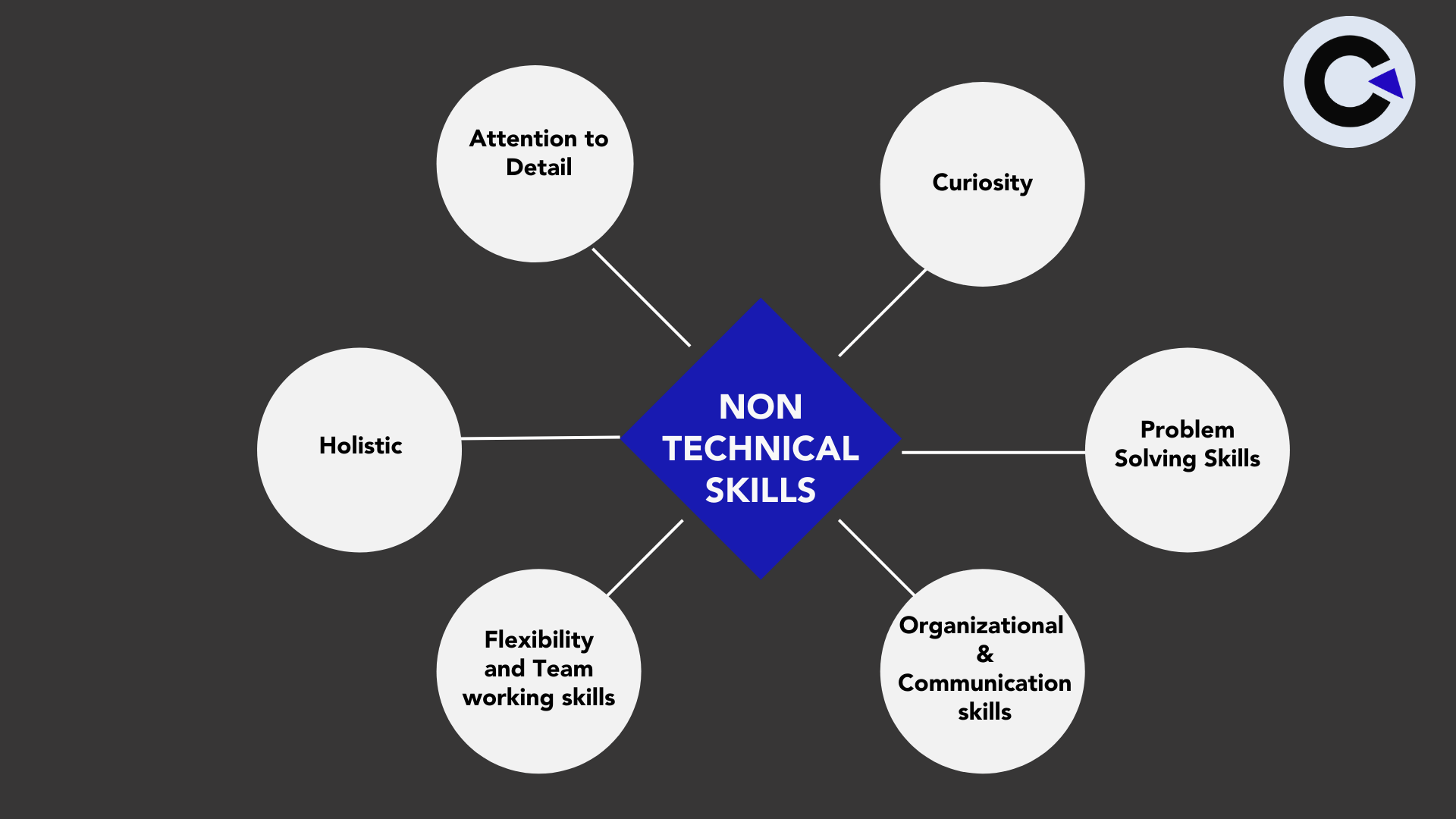
Passion is the very first non-technical aspect that you should be strong in and we have already covered that in the earlier part of this blog. So now let’s take a look at the other non-technical skills you would have to work on.
Attention to Detail
Oversight is never an acceptable option when it comes to software testing as one small oversight issue can create a ripple effect of serious issues down the lane. Stopping assumptions is the first step towards avoiding oversight. You can even improve such skills on a daily basis with the help of memory games, puzzles, and brain teasers.
Curiosity
The moment you make assumptions out of the equation, there will be a natural spur of curiosity in your brain. This curiosity will play a major role in helping you find bugs that could go undetected when following conventional methods. For example, if we take a look at exploratory testing, it definitely relies heavily on the tester’s intuition, creativity, and willingness to test new waters.
Problem-Solving Skills
Once you find a bug, you should never analyze it on a surface level, you should be able to identify the root cause of the issues. Such an approach will help you test better. Having an analytical and problem-solving mindset will also help you compartmentalize the software into smaller units and make the entire process more effective.
Organizational & Communication skills
Being well organized is definitely a must-have skill for all jobs. Even with regards to software testing, having all the data in a well-organized manner will definitely aid and boost your analytical skills. Plus, if the tester fails to use clear and comprehensible statements while creating test artifacts like test cases, test plans, test strategies, bug reports, and so on. The entire development process will see setbacks. Plus, as a software tester, you must be able to retrieve all such documents in a snap as you will never know when you will need them.
Flexibility and Team working skills
The communication skills should extend towards making yourself a team player as well. If you work in an agile environment, you would have to work in tandem with other teams as well. So make sure you show flexibility in internal aspects like willingness to perform any kind of testing. One should never stay within the comfort zone if one wants to improve and grow. Likewise, have a unified vision when working with other teams. There will be no point in playing the blame game with the developers once something bad happens.
Holistic
Yes, concentrating on something deeply is definitely a good sign to get effective results. But at the same time, you shouldn’t focus on just one or two aspects completely and lose track of the other parts of the application. If that happens, you might even miss the most straightforward bugs. So make sure your work is holistic in terms of coverage.
Conclusion
We hope you found all of this information to be useful. As stated earlier, don’t feel overwhelmed with the many skills you would need to become successful in your journey. As a leading QA company, we always make sure to implement a boot camp training session for all our new recruits by using the discussed skills as the base. We have found it to be very beneficial and hopefully, you will too.

by admin | Dec 2, 2021 | Software Testing, Blog, Latest Post |
If you had read that title and assumed that it isn’t possible to be true, then you assumed wrong. Facebook, now known as Meta does not employ dedicated personnel for testing their product. But you might wonder how it is possible for an application that has around 2.89 billion active users built using 60 million lines of code to work without testers. Here’s the catch, Facebook does in fact test its product. It just doesn’t employ dedicated people to get the job done. Instead, Facebook makes use of automation testing wherever possible. Automation also does have its own limitation as not all tests can be automated. So let’s find out Facebook’s Testing Strategy to manage this obstacle.
Facebook’s Testing Strategy
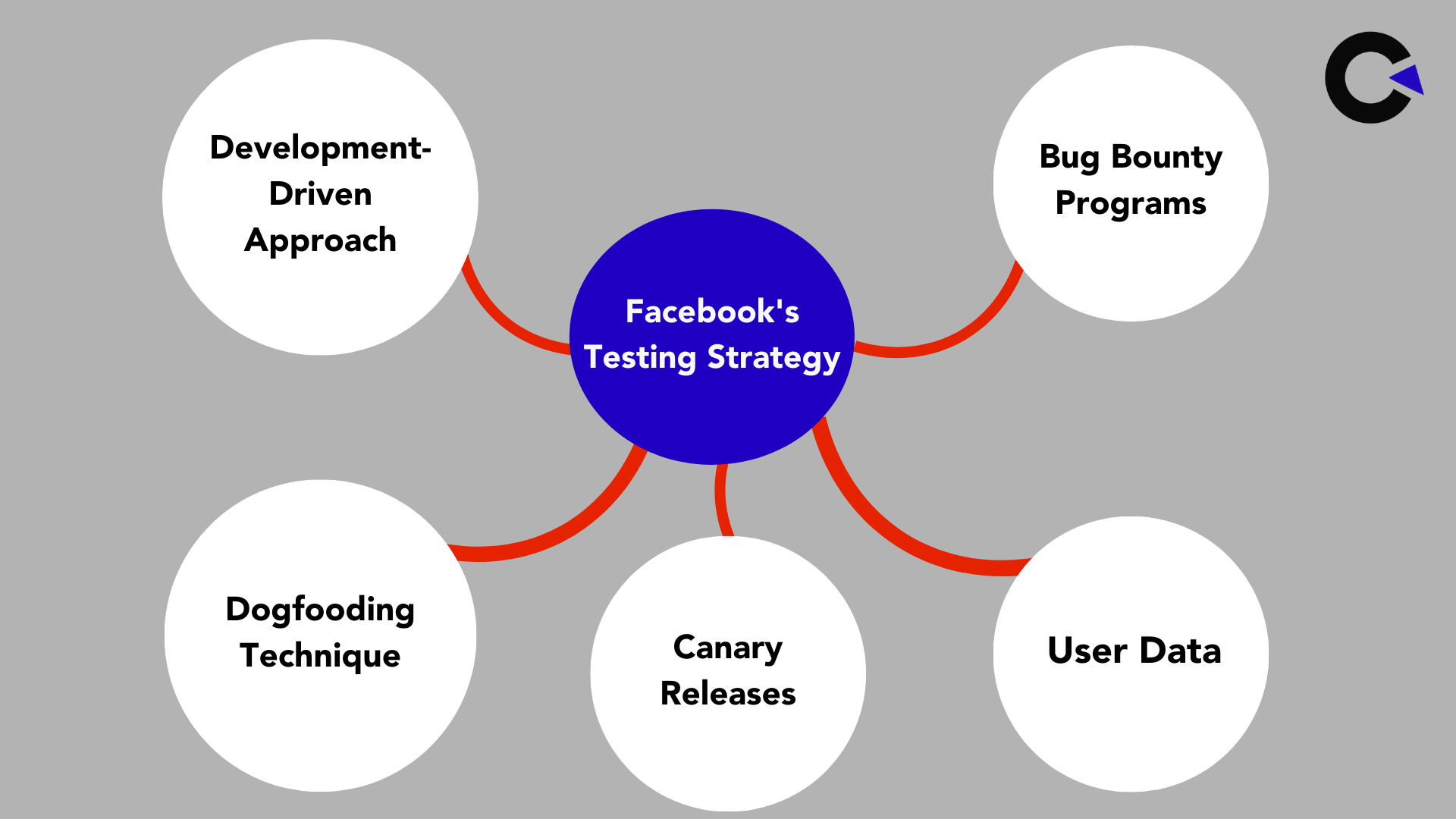
Development-Driven Approach
Facebook tries to reduce the number of bugs that get past the developers by making the developers test their own code and test each other’s code as well. Though developers will be more careful with their work, this method does lack the benefit of fresh and unbiased eyes reviewing the code.
Dogfooding Technique
Another one of Facebook’s Testing strategies is dogfooding all their employees by making them use the application. They are also provided with the required tools to report the bugs they find. So almost every employee is a tester in this scenario, but what makes it different is that testing alone isn’t their main task. Likewise, few employees will be focused more on QA, but that alone will not be their purpose.
Canary Releases
Facebook will not deploy any changes directly to their entire base. Instead, they make canary releases to their employees at first. If there are no reported issues, it is released to a smaller group of real-world users before it makes a worldwide release. Facebook’s various clients are also made to perform QA activities as their services are heavily reliant on the platform. Clients will be able to access the beta versions by visiting beta.facebook.com 24 hours prior to the release.
Bug Bounty Programs
As a part of Facebook’s Testing Strategy, they have been running bug bounty programs ever since 2011. It is used as a way to discover any major concerns that could have slipped past their existing tests. The prize amounts are calculated based on the severity and impact levels of the issues that are discovered. On the 10th anniversary of their bug bounty program, Facebook announced that had awarded over $1.98 Million for the winners. According to a former Facebook employee, they even have a few privileged channels through which ex-employees can report the issues they find. The employee also claimed that he reports around 13,000 bugs every month.
User Data
Owing to the larger user base, Facebook has large amounts of data at its disposal to monitor the performance of the newly deployed changes. Facebook has aggregated user reports and workflow success rates to analyze the success. It also keeps the existing users under check by using data like how many messages were sent during this hour of this week versus the previous week.
Are Testers not required?
Facebook’s Testing Strategy is in no way a perfect way to go about testing your product before a release. In fact, Facebook itself is aware of the shortcomings in its strategy. But they still follow it as Facebook feels social media is non-essential. This kind of approach shouldn’t come as a surprise as the motto for the company’s developers was “Move Fast and Break Things” until 2014. As a leading QA company, we believe that involving all the employees and developers to focus on testing makes it impossible for them to focus on their primary objectives to deliver their best. It is also a very messy plan that can be difficult to keep track of. A dedicated team can be instrumental in bringing down issues and costs in the longer run.

by admin | Nov 26, 2021 | Software Testing, Blog, Latest Post |
Prevention is better than cure is a great saying that even applies to the software development lifecycle. But it is almost impossible to develop software without any bugs on the very first try. So in order to keep up with the ever-growing need for rapid software development, it is vital for us to minimize the time taken to fix a bug. So it is very important to know the different types of software bugs detected during software testing as the complete knowledge of the type of bug you are dealing with will be instrumental in helping you understand the severity and in turn sort your priorities accordingly.
But before we explore the various types of software bugs, let’s first look into what classifies as a software bug. A software bug can be defined as an error or a fault that can render a computer program or even an entire system to crash or malfunction. So you will not get the desired or expected output despite providing a valid input. Though a glitch is different from a software bug, few might assume both to be the same. Due to the random nature of software glitches, it can be very difficult to find the cause and solve it like a software bug. But you might get lucky as glitches are known to correct themselves.
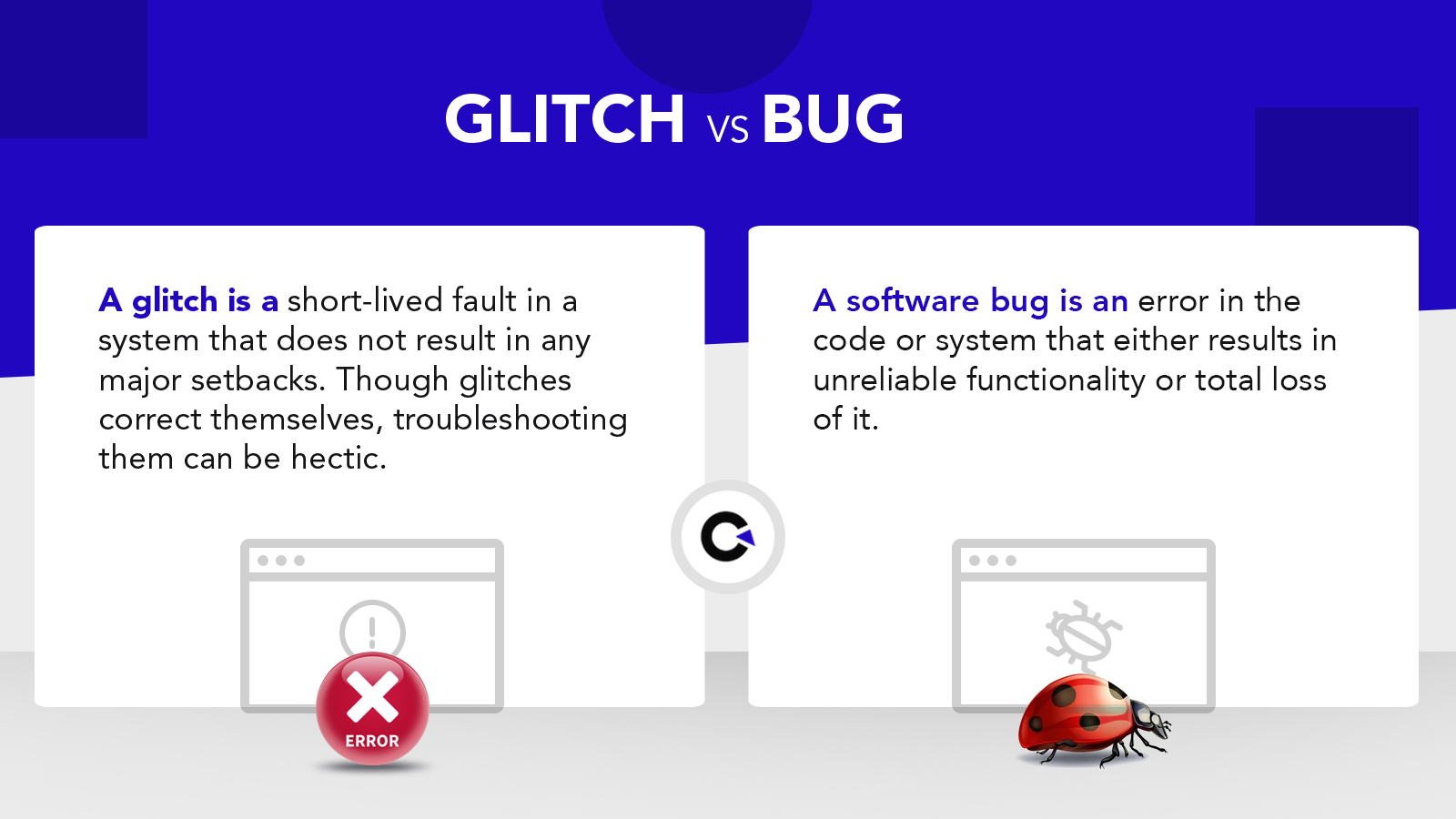
Origin of the Term ‘Bug’
Before dive in to explore the different types of software bugs, let’s take a look at some interesting trivia related to the term ‘bug’. The first-ever bug in a computer was reported by Grace Hopper back in 1946 and there is an interesting story behind how the term ‘bug’ came into use.
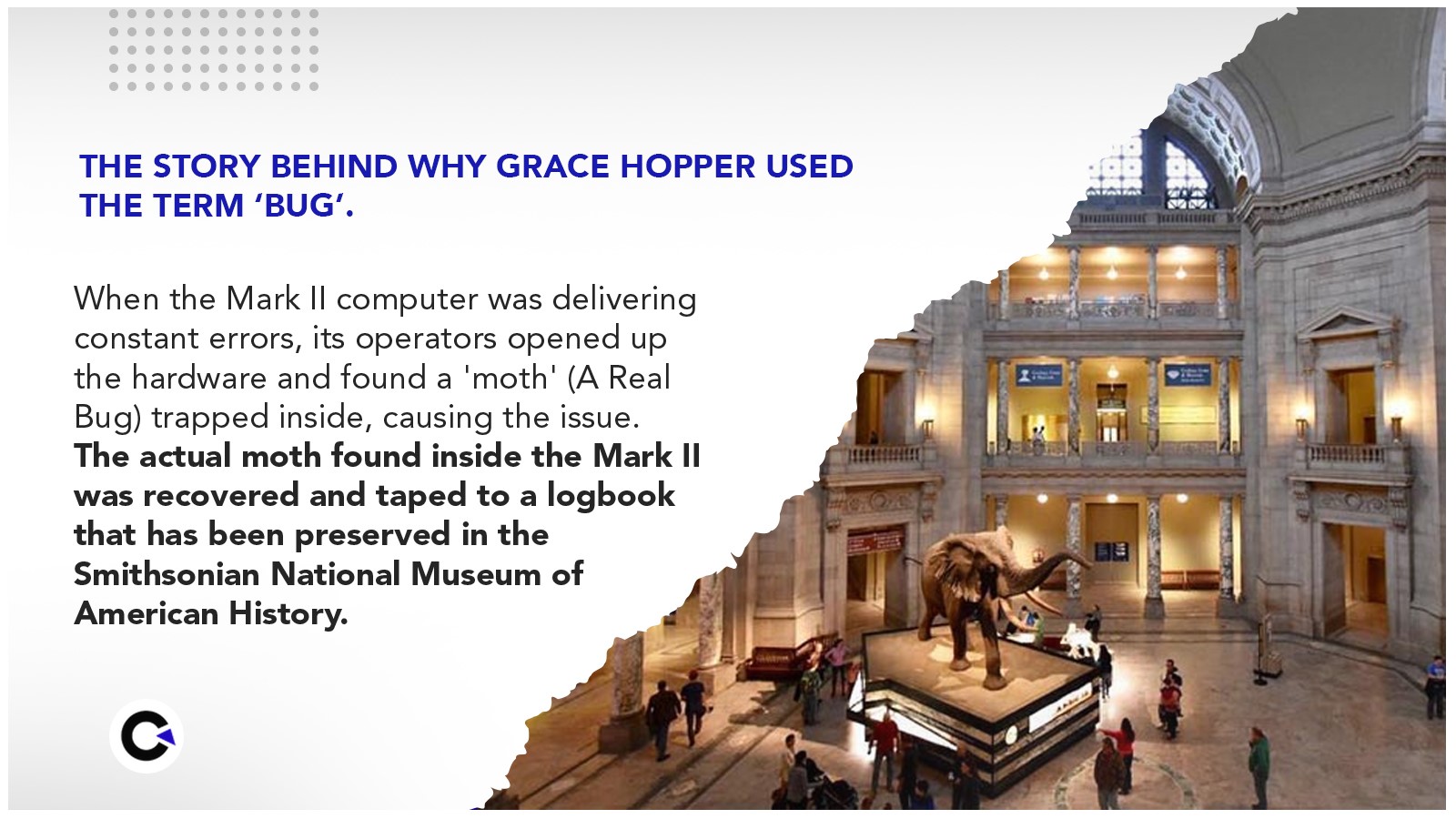
But some records suggest that the term ‘bug’ was used years back to denote an issue in a system.
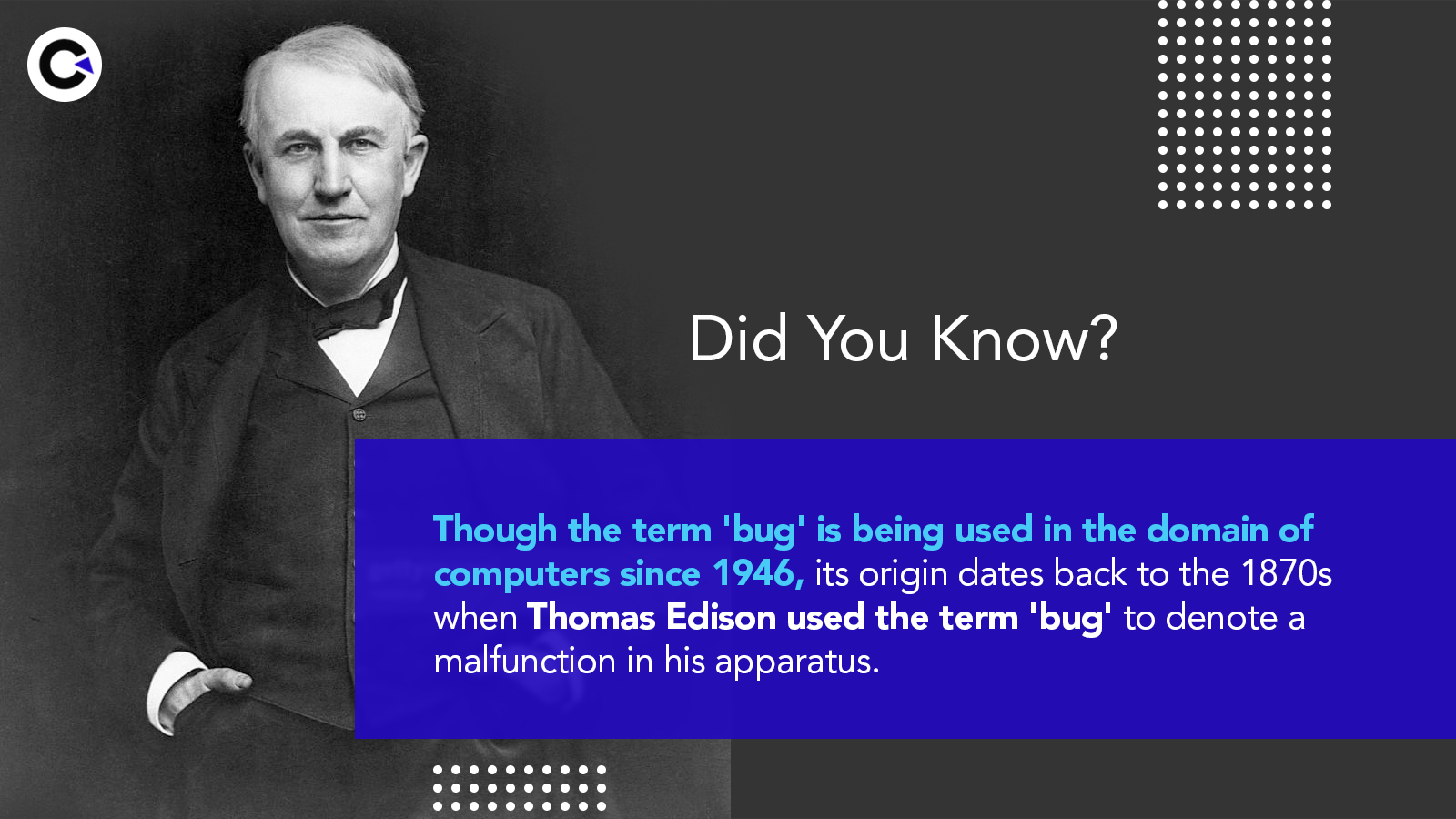
What are the Different Types of Software Bugs?
Let’s take a list of the various types of software bugs and then explore them one by one.
- Functionality Bugs
- Performance-based Bugs
- Usability Issues
- Safety Issues
- Compatibility Issues
- System-Level Integration Bugs
- Unit Level Bugs
Functionality Bugs
Every element in an application or a website will have a purpose for its existence. At times, it is possible for a few of these elements to not function as per the need or expectations. So such errors can be termed as functional bugs. The severity of these types of bugs could also be in different ranges. To bring that into perspective, a random non-functioning button that isn’t responding to clicks is also a functionality issue, and a malfunctioning login functionality that isn’t letting the users use the software is also a functionality issue. Owing to the broad nature of this type of bug, it is one of the most common bugs you will encounter. You have to be careful and not list every single bug you find under this category. Instead, you should take a closer look and classify it accordingly.
Performance-based Bugs
But just because a function works, doesn’t mean that everything is fine. According to a report, a delay of just one second decreases the customer’s satisfaction by 16%. Now, let’s say you are at the payment gateway and have entered your password or the OTP. The payment has to be verified and a success message has to be displayed in a very short span of time. If it takes 5 minutes for the success message to be displayed, then the user would be livid with your software. Similarly, if it works smoothly only once every 5 times, you would have to be counting on your luck to get that successful message. So speed, stability, resource consumption, etc. are a few performance issues that one might face.
Usability Issues
Over the years the number of fields in the sign-up form has been on the decline and usability is one of the major reasons. If it seems like too much work, users might shy away from creating an account or using the product altogether. You might have developed a great feature that can make a task easier for the user. But if the feature is hidden away in some menu making it hard for the user to find, it most probably will remain unused. There can also be workflow bugs that can make navigation through the software very difficult.
Accessibility issues are some of the most overlooked types of usability issues that make your product inaccessible to people with disabilities. As one of the leading QA companies, we provide the best web accessibility testing services and believe that everyone should have equal access to the various applications and websites in the market. Now let’s take a look at the few common accessibility issues that are usually found.

Safety Issues
With so much of our personal information at stake, safety and privacy have become major concerns for many users. The Covid-19 pandemic also resulted in a surge of security breaches as many products were left vulnerable due to their lack of focus on security. So make sure to look out for the following security issues.
- Encryption errors
- Buffer overflows
- Vulnerabilities in XSS
- Susceptibility to SQL injections
- Weak authentication
- Loopholes in role-based access
- Insecure deserialization
- Using components with known weaknesses
- Security misconfiguration
Compatibility Issues
If we take a mobile application as an example, compatibility is one mammoth challenge that the software development team has to overcome as there are so many mobile devices that are available in the market today. Each of these devices has its own display size & resolution, operating system, processors, and so on. So if you face any issues with a certain specification, then you would have to note it down. If you are developing a website, then you have to make sure it works fine across mobile devices, tabs, and computers. So just because everything works well in the defined circumstances, you can’t expect it to work the same way in real-world scenarios that have a lot of diversity.
System-Level Integration Bugs
Though the code for the different units of the software will be written by different software developers, it must all work together seamlessly. But it is not something that happens every time and you might encounter such issues when you are testing. You might something weird happening in the UI, or you might even witness memory overflow issues because of such bugs. So you can’t directly assume it is a UI issue as it might be caused due to the inconsistencies or incompatibilities across components. This makes it very hard to locate and resolve the issue as one would have to examine a larger chunk of code to identify the problem. So make sure to be extra careful when handling such complex issues.
Unit Level Bugs
Agile teams make use of unit tests to detect issues at the early stages of the software development so that they can be spotted and fixed easily. As a prominent agile testing services provider, we always focus on unit testing in all our projects. So it is highly important for you to know about unit-level bugs. If you are unaware of what unit tests are, they are nothing but the tests that are executed once a few models of the software have been developed. For example, if the sign-up page has been successfully developed, then the testers can verify that functionality alone with maximum coverage. Beyond the functionality, one could check if the data fields are accepting inputs as per the expectations. If the password must include both upper case and lower case letters, then it should not accept a password if this condition isn’t fulfilled.
The Other Different Types of Software Bugs
We have seen the major types of software bugs that you might come across while testing. Now we will be just skimming through the few other bugs that you should know about. The code might have syntax errors that prevent the code from compiling properly. Aspects like a missing character or bracket could cause such issues. Likewise, there might be unnecessary code duplication that is just making the software more bulky and slow. Apart from that, there could be logical errors in the code that can cause loss of functionality or even crash the application. Remember the example under the unit level bugs? You might face such out-of-bound bugs outside of unit testing too.
The Severity of the Different Software Bugs
By now you would have a pretty good idea of what types of software bugs will be severe and which ones have to be prioritized. Even if there is any confusion, the following example of a few bugs in an e-commerce website will help you get a crystal clear idea.
- Critical – If there is an issue that is preventing the users from even accessing the site due to a server issue or not allowing you to place an order, then that should be termed critical as all major functionalities have been blocked.
- High-level – This might also seem like a critical bug, but it is something that reduces functionality and not something that totally destroys it. For example, if you are able to access the site and place an order but not able to track the delivery. Here the main functionality is working, but still, there is a lot of inconveniences caused to the user while performing the main functionality (Shopping).
- Medium level – Minor or less important functionalities that impact a user’s experience with the product can be categorized here. A broken link or navigation issues are perfect examples.
- Low level – Bugs in this level will most probably be UI issues like alignment, typos, color issues, and so on.
Prioritization
Conventionally, many would assume that only the critical bugs should be resolved at the earliest. Though severity plays a major role in triaging which bugs to resolve first, complexity should also be considered. Critical bugs should get the main focus irrespective of how complex it is. But along with it, even small typos or issues that can be resolved much effort should also be fixed without any delay. It doesn’t matter if the bug is severe or not, a bug is still a bug and our plan should always be to fix it at the earliest. Highly severe bugs can be prioritized based on complexity. Whereas moderately severe bugs should be fixed by the next update.
Conclusion
We hope you had a good time reading our blog and now have a pretty good idea of the different types of software bugs you might have to deal with when testing. This is a list of the most common bugs you might face, there might be scenarios where you face bugs that are more complex or different in nature. But this list is a good place for you to start and then slowly up your skills as you move forward in your testing career.

by admin | Nov 19, 2021 | Software Testing, Blog, Latest Post |
Software testing is done to find anomalies in code that prohibit the product from performing as it should. These abnormalities are divided into specific groups to make debugging tasks more manageable for your team.
This article will explain the differences between bugs, errors, and issues so that QAs may be confident in cataloging, analyzing, and resolving these anomalies. Unfortunately, these flaws are guaranteed to appear while getting manual testing services for your website or app.
What is a Bug?
Any flaw in a software system that makes it act in unexpected and undesired ways is referred to as a bug. These might include unreasonable or inaccurate reactions, failed systems, and system crashes, among other things. It’s a programming fault that leads to software failure that can be discovered before the website or app is put into production.
Here are a few examples of bugs:
- Algorithm-related bugs
- Bugs that impair logic, such as infinite loops
- Uninitialized variables that cause bugs to appear
What is an Error?
Errors refer to coding or programming faults that are often caused by wrong syntax or erroneous loops. Inconsistencies or blatant fallacies in the underlying code structure cause errors to appear in the source code. Misconceptions, oversights, or misunderstandings on the developer’s part (engineers, testers, analysts, etc.) cause anomalies.
Errors come in a variety of forms:
- Calculation errors caused by incorrect formulas
- Errors in data handling due to the overwriting of required files
- Errors in configuration owing to a lack of storage capacity
What is an Issue?
The issue is a bit of a catch-all word. It signifies the presence of some abnormality in a software system that has to be resolved in software testing circles. As a result, an issue might be anything from a bug to missing or erroneous documentation, a feature request, or any other process that needs to be completed.
Issues are often assigned severity levels to be prioritized in the development and quality assurance hierarchy: high, medium, low, and cosmetic.
Clients and managers use the word “issue” to signify that something is wrong with the program at hand. It is often employed when the source of the problem is unknown. And once a problem has been identified, it must be investigated to determine its nature before being allocated to the appropriate team for remediation.
The Importance of Real Devices in Debugging and Problem-Solving
Identifying and removing any anomaly requires rigorous software testing on actual browsers and devices. Given the present state of browser-device fragmentation, every website or app must be accessible across various device-browser-OS combinations.
More than 4 billion people use various devices to access the internet, including:
- More than 9,000 different gadgets
- 21 distinct operating systems (vendor + version)
- Hundreds of browsers powered by eight primary browser engines
To ensure a favorable user experience across the board, there are 63,000 browser-platform-device combinations to test, and the number is continually growing. Due to the unique specifications of one particular browser, device, or OS, faults may appear on one combination but not on others. The program must be tested on various devices and browsers to guarantee that flaws and issues may be spotted across them.
Conclusion
Quality control operations include identifying defects, categorizing, reporting, and finally removing them. However, prevention is better than cure. The core of software quality assurance is to set up monitoring and inspection mechanisms at every level of the software development life cycle. Make sure to get optimal QA services to avoid any bug, error, or issue in your software.
Codoid is an industry leader in QA services. Our brilliant team of engineers is dedicated to helping clients overcome the challenges of complex manual testing services to grow a product. Contact us today!

by admin | Nov 8, 2021 | Software Testing, Blog, Latest Post |
Knowing each entity in depth is very important when it comes to testing banking applications that deal with corporate customers. Corporate Customers are the ones who are neither individuals nor micro-enterprises. With years of experience in providing the best software testing services to our clients, we are well-worse with everything a team will need to know about entities. So in this blog, we will be seeing an overview of entities on the whole as we will be learning what is an entity, exploring the Different Business Entities, and will also be covering how to test its intricacies.
What is an Entity?
An entity is a registered organization that processes and provides certain services to end consumers. It has its own goals & missions and a separate existence like humans. There are key representatives called the key principles of the organization who govern the entity. Now let’s take a look at the list of the different types of entities and explore them one by one.
The Different Business Entities:
- Public Limited Company
- Private Limited Company
- Partnership
- Sole proprietorship
- HUF
- Religious Establishment
- LLC
- Statutory Corporation
- Holding Company
- Trust
- Funds
- Non Profit Organizations
- Investment Vehicles
- State-Owned Entity
- Charitable Organizations
- Central Bank
- Sovereign Wealth Funds
- Clubs and Societies
Public Limited Company:
A public limited company offers shares of their stock to the general public by listing it on the stock exchange. The stakeholders are the owners of a PLC. It is referred to as PLC in the United Kingdom, as Inc in the United States, and as Ltd. In India. PLC requires a minimum number of 7 members, and there is no upper limit. It should also have at least 3 directors.
Private Limited Company:
A Private Limited Company can be listed in the stock exchange or need not be. Even if they hold shares, they cannot be sold to the general public. It requires a minimum of 2 members to start the company and it should have 2 or more directors. It is called LLC in the United States, PVT in the United Kingdom, and Pvt. Ltd in India.
Partnership:
A Partnership is a formal agreement between 2 or more parties to manage the business and share its profit or loss. Unlike Private Limited companies, partnership firms are not separate entities. A change in the partners leads to the formation of a new partnership firm while the old partnership firm would get dissolved. There should be a minimum of 2 partners, but the number should also not exceed 50.
Sole proprietorship:
When a company is owned and managed by a single owner, it is called a sole proprietorship. It is unincorporated by nature, meaning this company has no separate existence by itself. It is easy and inexpensive to establish when compared to the other entities as it has fewer regulations. The biggest challenge would be raising the required capital for the business from external sources. Small business owners mostly prefer sole proprietorships.
HUF
HUF is a family business that lends a way of saving taxes by clubbing the assets owned by the members of a family. Though it is an option available only in India, we wanted to be thorough in our proceedings. The senior-most member in the family will most probably be the head of their HUF. It is governed by Hindu Law. So the death of the senior member does not affect the existence of the business, the next senior-most male member becomes head.
Religious Establishment:
Temples, Churches, and Mosques are places of worship that can be termed as religious establishments. There are a lot of regulatory laws that help prevent the misuse of religious institutions as an unauthorized way of gaining money.
LLC (Limited Liability Company:
An LLC is a Legal Entity that helps its owners avoid personal responsibility for its debt and liabilities. LLCs do not pay tax as the profit or loss is passed to the owners who show it as their personal gain or loss. It is mostly incorporated, meaning the entity has a separate existence, unlike Sole Proprietary.
Statutory Corporation:
Statutory Corporations are companies owned by a government with the presence of other stakeholders. It is a cumbersome task to start such an entity as a lot of approvals are required. Once the policies governing this entity have been created, it is nearly impossible to change. So they are prone to wastage of capital & assets and inefficiency in operations compared to private establishments. It also suffers from political interference.
Holding Companies:
When multiple businesses are owned by a single person or by a group of people, they create a holding company which is called the ‘Parent Company’ to keep track of its subsidiaries. This holding company doesn’t usually perform any business activities, its primary purpose is to monitor the subsidiary businesses. So when the subsidiaries grow, their parent companies also grow in tandem. It receives dividends from its subsidiaries. The holding company either owns 100% of its subsidiary or at least 51% of its subsidiary to maintain control over it. This helps them to protect the interest of its subsidiary and helps to protect it from the creditors of the subsidiary to control the assets by investing less money.
Trust:
Trusts are owned by Banks or Financial Institutions and act as custodian for asset management, beneficial ownership registration, and so on. It acts on behalf of its client or beneficiary to make investment-related decisions.
Funds:
Funds are investment companies that focus on investing in securities. They employ portfolio managers to help manage the investment options offered by the firm.
Non Profit Organizations:
A non-profit organization can be a trust, a corporation, an association, a Limited Liability Company, or unincorporated. Since they are mainly created to serve a social cause, they will have tax exemption benefits.
To create a Non-Profit Organization, first, we have to decide if creating it as a non-profit is the right choice, create a mission statement, develop a business plan, build a board, and then file for the tax-exempt status.
Investment Vehicle:
An investment vehicle is a type of company that helps the investor grow their money by issuing bonds or investing in stocks or investing in real estate. Any mutual fund company that helps its investors diversify their portfolios is an example of an Investment Vehicle.
There is a special type of Investment Vehicle called the Special Purpose Vehicle (SPV). It is created by the parent company for the main purpose of undertaking some risky projects.
State-Owned Entity:
It is a company owned by the Government with the sole purpose of generating profits or helping the Government with certain activities that are vital to them.
Charitable Organizations:
It is a type of organization created with the sole purpose of aiding a social cause. It can be set up with the objective of safeguarding animals, protecting the environment, aiding in disaster recovery, and so on. The major difference between a charitable organization and an NGO is that it can run for profit. They accept funds from the general public for their survival.
Central Bank:
Central Bank is an entity that can be seen in every country and is called the Bank of Banks. They are responsible for the formulation of monetary policies and supervising or governing the other banks. It holds the privilege to issue currency notes for the nation. It eases or tightens the supply of money based on the demand to keep a nation’s economy on the positive side. It can be a lender when any financial institutions are in trouble.
Sovereign Wealth Funds:
It is an enterprise created by the Government to invest its surplus funds from any trade or budgeting. The sovereign wealth funds then invest that money in local industries to generate the return.
Clubs and Societies:
Based on the nature of Clubs and societies, it could be a non-profit or a profit-based entity whose profits go to the owner or can be saved by the club for a rainy day. Clubs can be established for fun & recreational activities, for people with similar interests, or even for social causes. They can grow to the extent of sponsoring an event or conducting a competition.
Testing Intricacies for the Different Business Entities:
Each entity type has its own intricacies based on its purpose and objective. We have mentioned the various testing considerations below.
Setting up an entity or type of Business
- Business rules pertaining to each of the entity types
- Nature of the business
- The process to add or modify the key owners or stakeholders of the entity.
- The type of registration that is required.
- Documentation requirements for setting up the entity.
- The workflow process for the approval or verification of an entity.
- Consider the variations in the country in which the setup is made based on and the country’s risk exposure as well.
- The economic condition of the country and its impact on the setup of the entity.
- Risk definition and approval mechanisms.
- The political influence and exposure of the business. (Could be added as a part of the Business Rules)
Below are the scenarios in which Testing should be mandated:
- When we need to create or set up an entity in a system, we are required to be aware of all the above areas and it has got its own influence on the setup. The primary focus area is on the Business Rules for each type of Entity.
- When we modify an entity type, we should again be careful to test all the above areas as business rules, country exposure, etc. might have different levels of impact.
- When there is new criteria or business rule imposed by a country, we need to do a round of post regression testing as the entity level rules change.
- When Risk exposure on a firm / Country / Region changes, we have to do another round of testing.
Since these entity setups mostly require multiple levels of approval and review, most of the applications will be standard workflow products like PEGA, IBM-BPM, TIBCO Business Studio, Appian, etc.
Conclusion
We hope you have found this blog to be informative and now have a clear picture of what an entity is, what the different types of entities are, and the intricacies you’ll have to know. As a leading QA company, we will be exploring such niche topics. So make sure to follow us on our social media handles to be updated with our blogs.






